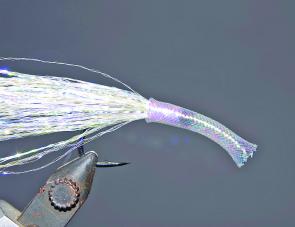During the next few months, the pelagic activity in the bay will be in full swing, heightened by the presence of schools of numerous baitfish species such as frogmouths and whitebait.
This month’s pattern, the Whitebait Wonder, is a handy one for this time of the year. When these bait schools are being ravished and decimated by pelagics such as mackerel, longtails, mack tuna and various frigates and bonito it is a highly productive offering. It’s a fairly simple pattern to tie and can be very productive either when stripped flat chat or simply allowed to sink adjacent to bait balls.
The Whitebait Wonder is a very useful pattern. Made from all synthetic materials, it can be trimmed easily enabling the profile of the fly to be decreased to match the profile of the bait on which pelagics are feeding. This is a highly useful as pelagics are often very profile orientated and will only eat an exact replica of the bait on which they are feeding. Often, a fly that is only 5mm longer than the bait will be met with refusal, while one that is the same profile will be eaten with gusto.
There are various ways in which the Whitebait Wonder can be worked to get the attention of predatory fish. When the baitfish are being set upon with wanton mayhem in a feeding frenzy, a cast fast and strip quick approach is often required. Using this technique the rod should be placed under the arm to allow a double-handed stripping retrieve. When the fish have the bait condensed in a tight pack called a ‘meat ball’, it is often best to cast the fly adjacent to the bait and just allow it to sink. It will regularly be slurped up by pelagics circling the edges of the school.
The Working Whitebait is best fished on an intermediate line. The near clear slime lines such as Scientific Anglers’ Striper Taper, are particularly effective. A fluorocarbon leader will also increase the chances of a successful take.
The materials used in this fly should be readily available at any store that keeps a reasonable array of saltwater fly tying materials. Using synthetics makes this a reasonably durable fly as well as looking the part in the briny. The Mylar tubing body is available in a variety of sizes and colours, including pearl, olive and silver and these combined with a broad array of colours in the Sparkleflash allows a lot of different combinations to be tied. The hook I use in this pattern is chosen with consideration of its dark colour, strength for size and super sharp point. While it is a reasonably small hook for this application, it is strong enough to be fished on 10kg tippets for even the largest longtail tuna. A Gamakatsu SC15 or SL12S are alternate options that may be more readily available. Over the entire fly we have applied two coats of Soft Dip (Tiewell) as this strengthens the fly considerably, stops the Mylar tube fraying and almost eliminates the chance of the tail fouling with the hook whilst casting.
1. Place the hook in the vice and attach the thread with a jamb knot (or similar) just behind the eye of the hook.
2. Cut a length of Mylar Tubing at least as long as the hook and remove the inner cotton core. Place the tubing over the hook eye as shown and tie in the end with a series of wraps. Whip finish off at this point, but do not cut away the remaining thread.
3. Cut a reasonable quantity of the Sparkleflash, approximately twice as long as the hook shank and as thick as the Mylar tubing. Tie it in, facing away from the Mylar tubing as shown. Whip finish at this point and then cut away the remaining thread. A little vinyl cement, or Flexcement, can be added to the tie in points to make them more durable.
4. The next step can be a little tricky. Push the Mylar tubing towards the tail of the fly with your fingers so that it turns inside out (inverts) as it rolls over and covers the Sparkleflash.
5. Once you have totally finished inverting the Sparkleflash, you will need to fray the end so that it can be finished as shown. Apply a coat of soft dip at this stage over the unfrayed section of Mylar tubing and allow it to dry.
6. Place the eyes on the fly and then trim the frayed section of Mylar tubing away with your scissors. The Sparkleflash tail will also need trimming to create a tapered profile as shown. Apply a second coat of soft dip over the entire Mylar tubing section and about the first 5-10mm of the Sparkleflash tail. Ensure to coat over the eyes of the fly to make them last longer as the eye is an extremely important part of any baitfish profile. Allow to dry, then put your Whitebait to good use on a broad array of Moreton Bay pelagics and other species such as tailor, trevally, tarpon and dart.
Facts
MATERIALS
| HOOK: | Owner Aki 1/0 |
|---|---|
| THREAD: | Clear mono- fine |
| BODY: | Mylar Tubing- medium pearl |
| TAIL: | Sparkleflash- #204 Holo UV Pearl |
| EYE: | 2mm Adhesive glow-in-dark |
| FINISH: | Soft dip (2 coats) |










